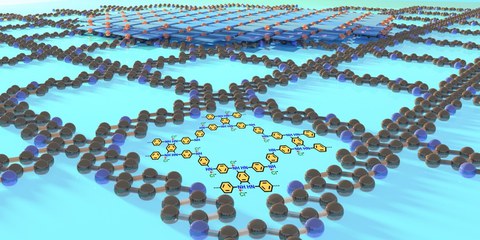Feb 12, 2025
Breakthrough in conductive polymers: New polymer crystal conducts electricity like a metal

Schematic of the on-water surface synthesis procedure for 2DPANI.
In a recent study published in the journal 'Nature', an international research team has developed a breakthrough two-dimensional conducting polymer - a special, ordered form of polyaniline (2DPANI) that demonstrates exceptional electrical conductivity and metallic charge transport behavior. The discovery is a fundamental breakthrough in polymer research, as it opens up new possibilities for the development of more efficient organic electronics.
Conducting polymers such as polyaniline, polythiophene, and polypyrrole are renowned for their excellent electrical conductivity and have emerged as promising low-cost, lightweight, and flexible alternatives to traditional semiconductors and metals. The significance of these materials was cemented in 2000 when the Nobel Prize in Chemistry was awarded to Alan J. Heeger, Alan G. MacDiarmid, and Hideki Shirakawa for their groundbreaking discovery and development of conductive polymers. This recognition highlighted the transformative potential of polymers in modern science and technology. Despite significant progress, these materials mainly conduct electrons along their polymer chains. However, conductivity between the polymer strands or layers remains limited because the molecules don't connect well and the electronic interactions are weak.
To solve this problem, a research team from TU Dresden and the Max Planck Institute of Microstructure Physics Halle, in collaboration with international partners, has synthesized and characterized a multilayered two-dimensional polyaniline crystal (2DPANI). "This material exhibits exceptional conductivity - not only within its layers, but also vertically across the layers. This is what we call metallic out-of-plane charge transport or 3D conduction. This is a fundamental breakthrough in polymer research," explains Thomas Heine, Chair of Theoretical Chemistry at TU Dresden. Together with his team at TU Dresden and the Center for Advanced Systems Understanding CASUS in Görlitz, he first simulated the structure of the polymer and calculated its metallic character.
Xinliang Feng and his team at the Center for Advancing Electronics Dresden (cfaed) at TU Dresden and the Max Planck Institute of Microstructure Physics in Halle synthesized the new polymer and carried out direct current transport studies. These measurements show an anisotropic conductivity of 16 S/cm in-plane and 7 S/cm out-of-plane - about three orders of magnitude higher than conventional linear conducting polymers. . Furthermore, low-temperature measurements show that out-of-plane conductivity increases as temperature decreases—a characteristic behavior of metals—confirming the material’s exceptional metallic out-of-plane electric transport properties.
Further measurements were carried out at CIC nanoGUNE in San Sebastián, Spain using infrared and terahertz near-field microscopy. These revealed a DC conductivity of around 200 S/cm.
This breakthrough opens up the possibility of achieving three-dimensional metallic conductivity in metal-free organic and polymeric materials. This opens up exciting new prospects for applications in electronics, electromagnetic shielding and sensor technology. The metallic polymer could serve as a functional electrode in electrochemistry and photoelectrochemistry, for example for the production of hydrogen.
Original publication:
Tao Zhang, Shu Chen, [...], Thomas Heine, Renhao Dong, Rainer Hillenbrand & Xinliang Feng. Two-dimensional polyaniline crystal with metallic out-of-plane conductivity. Nature (2025). https://doi.org/10.1038/s41586-024-08387-9
Scientific contact:
Prof. Dr. Thomas Heine
Chair of Theoretical Chemistry
TU Dresden
Phone: +49 351 463-37637
E-mail:
Prof. Xinliang Feng
Chair of Molecular Functional Materials
Phone: +49-(0)351-463-43251
E-mail:
Media contact:
Matthias Hahndorf
Science Communication cfaed
Phone: +49 (0)351 463 42847
E-mail:
Nicole Gierig
Public Relations
School of Science
Phone: +49 (0)351 463 29504
Email:
